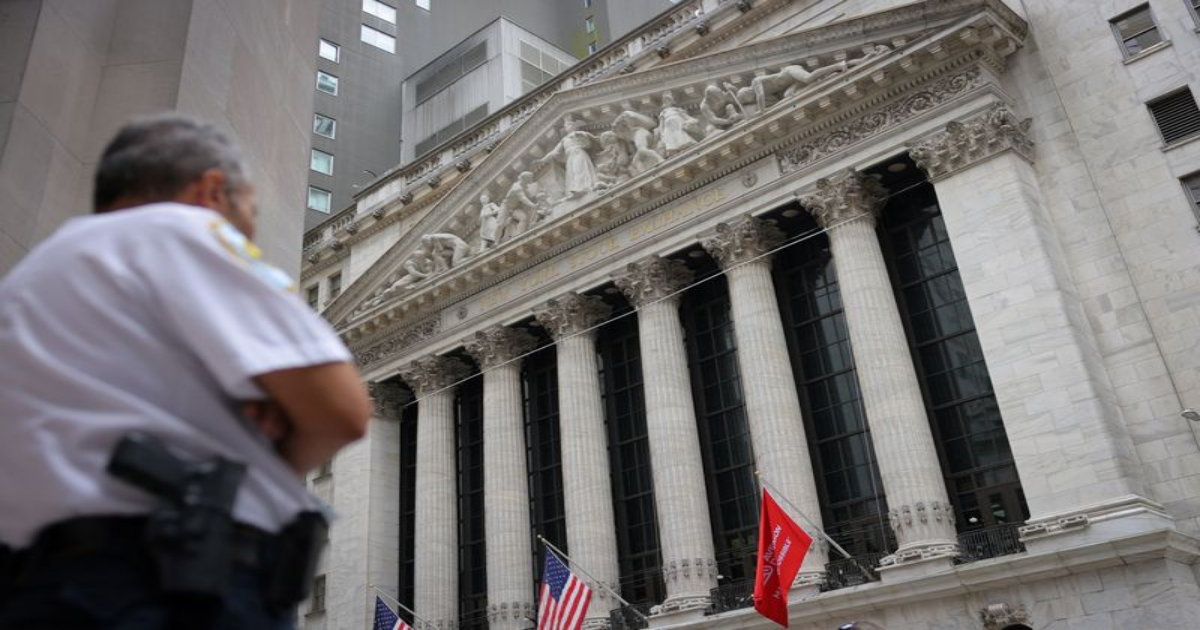By Jamie McGeever
ORLANDO, Florida (Reuters) – TRADING DAY
Making sense of the forces driving global markets
By Jamie McGeever, Markets Columnist
America’s ’emerging market tendencies’
If there’s an upside for U.S. markets to President Donald Trump’s verbal tirade against Federal Reserve Chair Jerome Powell, it’s not immediately obvious – Wall Street, the dollar and long-dated Treasuries all tanked on Monday, and investors are bracing for further volatility.
Gold, the yen and key European currencies all rose sharply. But with the credibility of U.S. policymaking and governance at the root of the market turbulence, Treasuries and the dollar are longer part of that club of core ‘safe haven’ assets.
More on that below, but first, a round-up of Monday’s main market moves. I’d love to hear from you, so please reach out to me with comments at . You can also follow me at @ReutersJamie and @reutersjamie.bsky.social.
If you have more time to read today, here are a few articles I recommend to help you make sense of what happened in markets.
1. US multinationals extend currency hedges to counterTrump’s tariff volatility 2. China warns countries against striking trade deals withUS at its expense 3. Tariff deal talks to dominate IMF-World Bank meetingsthis week 4. Trump studying whether to fire Fed Chair Powell, advisersays 5. BOJ likely to keep rate-hike signal intact despite Trumptariff risks, sources say
Today’s Key Market Moves
* Wall Street slumps, with the S&P 500, Nasdaq and Dow alllosing 2% or more. The Nasdaq slips back into bear marketterritory. * All 10 sectors in the S&P 500 end in the red, led byconsumer cyclicals falling 2.8%. Eight sectors lose 2% or more. * The dollar tanks, to a 10-year low against the Swiss francand a three-year low against a basket of G10 currencies. * The euro climbs to $1.1573, highest since November, 2021. * Gold leaps nearly 3% to a fresh high of $3,430/oz. * Treasuries undergo substantial curve steepening, with the2-year yield falling 6 bps and 30-year yield spiking 10 bps. * U.S. 2s/30s curve steepens to 115 bps, its highest closinglevel since January 2022. * Oil falls more than 2% – Brent crude settles at$66.26/bbl.
Trump pummels Powell
The U.S. President is known more for doubling down than backing down, so in that sense his renewed attacks on Fed Chair Powell should come as no surprise. But they are still no less astonishing for that.
In a pointed post on his Truth Social platform, Trump said the U.S. economy is headed for a slowdown “unless Mr. Too Late, a major loser, lowers interest rates NOW.”
It is the latest in a series of criticisms that investors see as blatant attempts at political interference with the monetary policy setting process, and direct attacks on the central bank’s independence.
Investors are understandably spooked. Economist Phil Suttle says the twin selloff in Treasuries and the dollar suggest U.S. markets are “giving off distinct emerging market tendencies,” while Callie Cox at Ritholtz Wealth Management notes that U.S. markets are on the cusp of a cross-asset drop not seen for 35 years.
Cox calculates that the last time the S&P 500 was down 8.5%, the dollar was lower, and the 10-year Treasury yield rose in the same calendar month was August 1990.
The S&P 500’s bounce off its lows late on Monday means the index is currently down 8.1% this month, so we’re not quite there yet. But it’s close, and in the current climate, few would bet against it.
The clearest winner in this turbulence is gold. Since hitting a post-‘Liberation Day’ low of $2,955 an ounce on April 7, bullion has risen 15% through $3,400/oz. What appeared to be extremely bullish forecasts of $3,500/oz earlier this year no longer seem so outlandish.
Beyond Trump’s spat with Powell, investors are also trying to navigate a global trade war. Trump’s recent 90-day pause in many U.S. tariffs offered welcome relief, but trade could come back to haunt markets this week as hundreds of global finance leaders descend on Washington for the semi-annual gatherings of the International Monetary Fund and World Bank Group.
Dollar would be biggest casualty if Trump fires Fed Chair
If U.S. President Donald Trump wants a weaker dollar, threatening to fire Federal Reserve Chair Jerome Powell is a sure-fire way of getting it.
But rarely in markets, economics and policymaking has the phrase “be careful what you wish for” ever been more apt.
Trump’s frustration with Powell for not lowering interestrates goes back to his first term in the White House, but hislatest verbal attacks mark an escalation that could quickly turna dollar slump into a potentially catastrophic rout.
That’s not hyperbole. The dollar is down 9% this year andhas lost almost 6% of its value this month alone, a slide thataccelerated when Trump’s “Liberation Day” tariffs threw marketsinto a downward spiral of uncertainty and confusion.
The dollar’s decline this year has wiped out all of lastyear’s gains, which is quite a feat considering the tsunami ofcapital inflows as investors around the world plowed trillionsinto Wall Street on the back of the “U.S. exceptionalism” story.
Measured against a basket of major currencies, the dollar ison track for its steepest monthly decline since the GlobalFinancial Crisis of 2007-09, and its eighth biggest since theera of free-floating exchange rates was introduced more than 50years ago.
Excluding the GFC, the last time the dollar fell this muchin a calendar month was in 1985, just before five countriesagreed to weaken what was legitimately an overvalued dollar viathe famed “Plaza Accord” in September of that year.
The scale of dollar selling underway now is historic, andworryingly for policymakers, it appears to be rooted in concernabout the direction and credibility of U.S. policymaking.
There’s almost nothing that could undermine credibility in acountry’s economic policymaking – and its currency – more thanforcibly removing the head of the central bank: Even in theUnited States and even the dollar. Or perhaps, especially in theU.S. and especially the dollar, because of the outsized roleboth play in the global financial system.
Former Boston Fed President Eric Rosengren put in plainly onMonday when he wrote on the social media platform X: “Unless thegoal is to make the US trade like a third-world country,threatening Federal Reserve independence only makes the US lessattractive to foreign investors.”
POLYMARKET ODDS
Of course, the doomsday scenario may be avoided. Trump couldback down or soften his stance, Powell might decide tovoluntarily step down to limit the damage, or markets could takethe view that his replacement may not be so bad after all. Butright now, there’s little to suggest any of those scenarios willplay out.
In the near term, Powell’s exit would probably prompt animmediate, dovish repricing of the Fed’s rate outlook.
Traders currently expect the Fed to cut interest rates by100 basis points this year to 3.25-3.50%, but that’s with Powellattempting to balance growth concerns with any rising pricepressures. A Fed more in tune with Trump’s thinking would tiltthat balance in the direction of more easing.
But that’s only part of the story because continued dollarweakness wouldn’t be welcomed by other countries, whosecurrencies would be rising in value against the greenback.Moreover, shattered faith in the dollar would risk unleashingtremors that could rip through global markets in unexpectedways. Official intervention would surely come at some point.
But would it succeed?
“Fending off a speculative attack (on the dollar) would bechallenging,” warns economist Phil Suttle, even for the Fed, asU.S. rates would probably be falling in such a fevered “riskoff” environment.
Redrawing the world’s economic architecture is one ofTrump’s economic goals. Political interference in the centralbank, unmooring inflation expectations and torpedoing theworld’s faith in the dollar would certainly do that, but it’s ahigh price to pay.
Online prediction market Polymarket is currently attaching a19% chance to Powell getting fired by the end of this year, upfrom around 15%, where it has hovered for most of this year, butdown from as high as 23% last week. Unless Trump has a suddenchange of heart, this probability – and pressure on the dollar -is likely to rise.
What could move markets tomorrow?
* U.S. 2-year Treasury note auction * IMF/World Bank Spring Meetings in Washington * Five Fed officials – Philip Jefferson, Patrick Harker,Neel Kashkari, Thomas Barkin and Adriana Kugler – all speakingat different events * ECB’s Klaas Knot speaks in Washington
Opinions expressed are those of the author. They do not reflect the views of Reuters News, which, under the Trust Principles, is committed to integrity, independence, and freedom from bias.
Trading Day is also sent by email every weekday morning. Think your friend or colleague should know about us? Forward this newsletter to them. They can also sign up here.
(By Jamie McGeever, editing by xxxxxxxxx)



